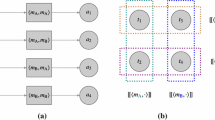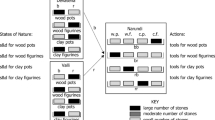...a singing creature, only associating thoughts with tones.
von Humboldt (1836)
Abstract
Natural languages are compositional in that the meaning of complex expressions depends on those of the parts and how they are put together. Here, I ask the following question: why are languages compositional? I answer this question by extending Lewis–Skyrms signaling games with a rudimentary form of compositional signaling and exploring simple reinforcement learning therein. As it turns out: in complex worlds, having compositional signaling helps simple agents learn to communicate. I am also able to show that learning the meaning of a function word, once meanings of atomic words are known, presents no difficulty.

Similar content being viewed by others
Notes
A related literature also focuses on making the statement of (C) more precise so as to avoid worries that it is trivial and/or vacuous. See, for an overview, §2.1 of Pagin and Westerståhl (2010b). In what follows, I will assume that (C) has been formulated in an appropriately more precise way.
For learnability, see Davidson (1964). For systematicity and productivity, see Fodor and Pylyshyn (1988), Fodor (1987), and Fodor (1998). Some also take the principle to be a methodological one, guiding inquiry in semantics. See Szabó (2013), Pagin and Westerståhl (2010a, b), and Janssen (1997) for overviews of all of these proposals.
This corresponds to one of two types of informational content for a signal identified in chapter 3 of Skyrms (2010) and reflects the idea that a proposition is a set of possible worlds.
In not having the utility function depend on the signal sent, we are assuming that no signal is more costly to send than any other.
A matrix with only 1s and 0s, where each row has a single 1 and distinct rows have 1s in distinct columns.
Here, \(M^T\) denotes the transpose of M, i.e. \(\left( M^T \right) _{ij} = M_{ji}\).
For instance, the ball-in-urn metaphor essentially assumes that the utility function only has integer values.
See Skyrms (2010), p. 94.
See Seyfarth et al. (1980).
See Schlenker et al. (2014) for a detailed semantic analysis of this form of signaling. They in fact find that the basic alarm calls have roots with a morphological suffix.
See Hassani (2003) for the definition and applications.
To fully model classical logical negation, we would also need to require that f is an involution, i.e. that \(f\left( f\left( i \right) \right) = i\). But since our syntax is so impoverished that sending a “double negation” signal is not possible, we can omit this requirement. It is also doubtful that natural language negation satisfies double negation elimination. This remark about involutions does, however, explain why we have 2n states and acts: a permutation that is an involution will only have cycles of length \(\le \)2. And being a derangement requires that there are no cycles of length 1. Together, this means that \(\left[ n \right] \) only has derangements which are involutions if n is even.
Or equivalently:
$$\begin{aligned} \sigma \left( s_j \right) \left( \boxminus m_i \right)&\propto \sigma \left( f^{-1}\left( s_j \right) \right) \left( m_i \right) \\ \rho \left( \boxminus m_i \right) \left( a_j \right)&= \rho \left( m_i \right) \left( f^{-1}\left( a_j \right) \right) \end{aligned}$$For Barrett, this means \(\pi \left( \sigma , \rho \right) > 0.8\).
Though it’s worth noting that \(\sigma \left( s_{AB} \right) \left( m_{AB} \right) \le 1/2\) so that \(m_{AB}\) never becomes strongly associated with \(s_{AB}\).
References
Argiento, R., Pemantle, R., Skyrms, B., & Volkov, S. (2009). Learning to signal: Analysis of a micro-level reinforcement model. Stochastic Processes and their Applications, 119(2), 373–390. doi:10.1016/j.spa.2008.02.014.
Barrett, J. A. (2006). Numerical simulations of the Lewis signaling game: Learning strategies, pooling equilibria, and the evolution of grammar. Technical report, Institute for Mathematical Behavioral Sciences, 2006. http://escholarship.org/uc/item/5xr0b0vp
Barrett, J. A. (2007). Dynamic partitioning and the conventionality of kinds. Philosophy of Science, 74(4), 527–546.
Barrett, J. A. (2009). The evolution of coding in signaling games. Theory and Decision, 67(2), 223–237. doi:10.1007/s11238-007-9064-0.
Beggs, A. W. (2005). On the convergence of reinforcement learning. Journal of Economic Theory, 122(1), 1–36. doi:10.1016/j.jet.2004.03.008.
Bergstrom, C. T., & Dugatkin, L. A. (2012). Evolution. New York: W. W. Norton.
Davidson, D. (1964). Theories of meaning and learnable languages. In Inquiries into truth and interpretation (pp. 3–16). Oxford: Oxford University Press. doi:10.1093/0199246297.001.0001
Fodor, J. (1987). Psychosemantics. Cambridge, MA: The MIT Press.
Fodor, J. (1998). In critical condition: Polemical essays on cognitive science and the philosophy of mind. Cambridge, MA: The MIT Press.
Fodor, J., & Pylyshyn, Z. W. (1988). Connectionism and cognitive architecture. Cognition, 28(1–2), 3–71. doi:10.1016/0010-0277(88)90031-5.
Franke, M. (2014). Creative compositionality from reinforcement. In E. A. Cartmill, S. Roberts, H. Lyn, & H. Cornish (Eds.), The evolution of langauge (Proceedings ofEvoLang 10) (pp. 82–89). Singapore: World Scientific.
Frege, G. (1923). Logische Untersuchungen. Dritter Teil: Gedankengefüge (“Compound Thoughts”). Beiträge zur Philosophie des deutschen Idealismus, III, 36–51. doi:10.1093/mind/LI.202.200.
Futuyma, D. J. (2010). Evolutionary constraint and ecological consequences. Evolution, 64(7), 1865–1884. doi:10.1111/j.1558-5646.2010.00960.x.
Glimcher, P. W. (2011). Understanding dopamine and reinforcement learning: The dopamine reward prediction error hypothesis. Proceedings of the National Academy of Sciences, 108(42), 15647–15654. doi:10.1073/pnas.1014269108.
Haldane, J. B. S. (1932). The causes of evolution. London: Longmans, Green, and co.
Hassani, M. (2003). Derangements and applications. Journal of Integer Sequences, 6. http://www.emis.ams.org/journals/JIS/vol6.html.
Hofbauer, J., & Huttegger, S. M. (2008). Feasibility of communication in binary signaling games. Journal of Theoretical Biology, 254(4), 843–849. doi:10.1016/j.jtbi.2008.07.010.
Hofbauer, J., & Huttegger, S. M. (2015). Selection-mutation dynamics of signaling games. Games, 6(1), 2–31. doi:10.3390/g6010002.
Hu, Y., Skyrms, B., & Tarrès, P. (2011). Reinforcement learning in signaling game. http://arxiv.org/abs/1103.5818
Huttegger, S. (2007). Evolution and the explanation of meaning. Philosophy of Science, 74(1), 1–27. doi:10.1086/519477.
Janssen, T. M. V. (1997). Compositionality. In: J. van Benthem, A. ter Meulen (eds.), Handbook of logic and language, chapter 7, pp. 417–473. Elsevier Science. doi:10.1016/B978-044481714-3/50011-4.
Lewis, D. (1969). Convention. Oxford: Blackwell.
Nowak, M. A., & Krakauer, D. C. (1999). The evolution of language. Proceedings of the National Academy of Sciences of the United States of America, 96, 8028–8033.
Pagin, P., & Westerståhl, D. (2010a). Compositionality I: Definitions and variants. Philosophy Compass, 5(3), 250–264. doi:10.1111/j.1747-9991.2009.00228.x.
Pagin, P., & Westerståhl, D. (2010b). Compositionality II: Arguments and problems. Philosophy Compass, 5(3), 265–282. doi:10.1111/j.1747-9991.2009.00229.x.
Pawlowitsch, C. (2008). Why evolution does not always lead to an optimal signaling system. Games and Economic Behavior, 63(1), 203–226. doi:10.1016/j.geb.2007.08.009.
Roth, A. E., & Erev, I. (1995). Learning in extensive-form games: Experimental data and simple dynamic models in the intermediate term. Games and Economic Behavior, 8, 164–212.
Schlenker, P., Chemla, E., Arnold, K., Lemasson, A., Ouattara, K., Keenan, S., et al. (2014). Monkey semantics: two ‘dialects’ of Campbell’s monkey alarm calls. Linguistics and Philosophy, 37(6), 439–501. doi:10.1007/s10988-014-9155-7.
Schultz, W. (2004). Neural coding of basic reward terms of animal learning theory, game theory, microeconomics and behavioural ecology. Current Opinion in Neurobiology, 14(2), 139–47. doi:10.1016/j.conb.2004.03.017.
Schultz, W., Dayan, P., & Montague, P. R. (1997). A neural substrate of prediction and reward. Science, 275, 1593–1599.
Seyfarth, R. M., Cheney, D. L., & Marler, P. (1980). Vervet monkey alarm calls: Semantic communication in a free-ranging primate. Animal Behavior, 28, 1070–1094.
Skyrms, B. (1996). Evolution of the social contract. Cambridge, MA: Cambridge University Press.
Skyrms, B. (2004). The stag hunt and the evolution of social structure. Cambridge, MA: Cambridge University Press.
Skyrms, B. (2010). Signals: Evolution, learning, and information. Oxford: Oxford University Press.
Sutton, R. S., & Barto, A. G. (1998). Reinforcement learning: An introduction. Bradford: The MIT Press.
Szabó, Z. G. (2013). Compositionality. The Stanford Encyclopedia of Philosophy, Fall. http://plato.stanford.edu/archives/fall2013/entries/compositionality/
Trapa, P. E., & Nowak, M. A. (2000). Nash equilibria for an evolutionary language game. Journal of Mathematical Biology, 41(2), 172–188. doi:10.1007/s002850070004.
von Humboldt, W. (1836). On language: On the diversityof human language construction and its influence on the mentaldevelopment of the human species. Cambridge Texts in the Historyof Philosophy. Cambridge University Press.
Zuberbühler, K. (2002). A syntactic rule in forest monkey communication. Animal Behaviour, 63(2), 293–299. doi:10.1006/anbe.2001.1914.
Acknowledgments
I would like to thank the organizers and participants at IDAS’14 and especially Stefano Demichelis and Roland Muehlenbernd for stimulating discussion. An earlier version was presented at a workshop on Knowledge, Argumentation, and Games in Amsterdam. For discussion there, I thank especially Michael Franke and Alexandru Baltag. Jeffrey Barrett, Johan van Benthem, Thomas Icard, Chris Potts, Carlos Santana, Brian Skyrms, and Michael Weisberg have provided helpful comments on earlier versions of this paper as did three anonymous referees for this journal.
Author information
Authors and Affiliations
Corresponding author
Rights and permissions
About this article
Cite this article
Steinert-Threlkeld, S. Compositional Signaling in a Complex World. J of Log Lang and Inf 25, 379–397 (2016). https://doi.org/10.1007/s10849-016-9236-9
Published:
Issue Date:
DOI: https://doi.org/10.1007/s10849-016-9236-9




